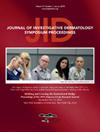Investigation of Psoriasis Susceptibility Loci in Psoriatic Arthritis and a Generalized Pustular Psoriasis Cohort
Q2 Medicine
Journal of Investigative Dermatology Symposium Proceedings
Pub Date : 2018-12-01
DOI:10.1016/j.jisp.2018.09.008
引用次数: 5
银屑病关节炎和广泛性脓疱性银屑病队列中银屑病易感位点的研究
牛皮癣是一种常见的皮肤病,影响1-3%的人口(Gelfand等人,2005;Ferrándiz et al., 2001)。大约30%的银屑病患者会发展为银屑病关节炎(PsA),一种与银屑病相关的炎症性关节炎(Haroon et al., 2013;Prey et al., 2010)。广泛性脓疱性牛皮癣(GPP)影响约1.3%的牛皮癣患者。近年来,通过全基因组关联研究(GWASs)的应用,发现了许多新的寻常型银屑病(PsV)易感位点。其中,主要组织相容性复合体是影响最强的位点。在主要组织相容性复合体区域之外,新的PsV易感位点可以被纳入一个综合致病模型,该模型包括影响皮肤屏障功能的不同信号网络、涉及NF-κB信号的先天免疫反应和涉及CD8 T细胞和IL-23/ il -17介导的淋巴细胞信号的适应性免疫反应。与PsV相比,PsA中仅进行了3次GWASs (Ellinghaus et al., 2012;h ffmeier等人,2010;Stuart et al., 2015),连同其他候选基因研究,大多数PsA易感位点已被证明与PsV相关。然而,GPP的遗传研究却大不相同。IL36RN是目前唯一被广泛证实的GPP相关基因。数据基于常染色体隐性遗传GPP的突尼斯多家族的纯合子作图和直接测序(Marrakchi et al., 2011)。一些研究者认为GPP和PsV在病因学上是不同的临床实体(Capon, 2013),挑战了对银屑病的传统认识。据报道,il36rn阴性患者的百分比从51% (Li et al., 2013)到84% (Setta-Kaffetzi et al., 2013)不等,这意味着额外的风险位点、遗传相互作用和其他因素可能是其他GPP病例的原因。最近,超过10个PsV的GWASs已经确定了一些易感位点,使PsV GWASs成为其他亚型牛皮癣潜在风险位点的丰富来源。在这里,我们使用来自PsV GWASs的信息来推断中国人群中PsA和GPP的遗传病因。
本文章由计算机程序翻译,如有差异,请以英文原文为准。
求助全文
约1分钟内获得全文
求助全文
来源期刊
自引率
0.00%
发文量
0
期刊介绍:
Journal of Investigative Dermatology Symposium Proceedings (JIDSP) publishes peer-reviewed, invited papers relevant to all aspects of cutaneous biology and skin disease. Papers in the JIDSP are often initially presented at a scientific meeting. Potential topics include biochemistry, biophysics, carcinogenesis, cellular growth and regulation, clinical research, development, epidemiology and other population-based research, extracellular matrix, genetics, immunology, melanocyte biology, microbiology, molecular and cell biology, pathology, pharmacology and percutaneous absorption, photobiology, physiology, and skin structure.

 求助内容:
求助内容: 应助结果提醒方式:
应助结果提醒方式:


